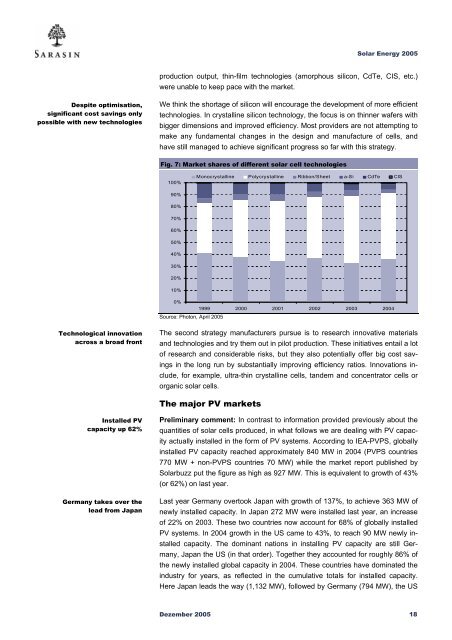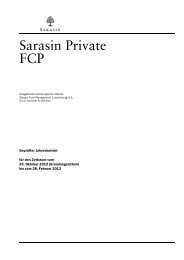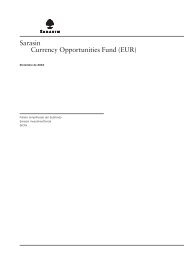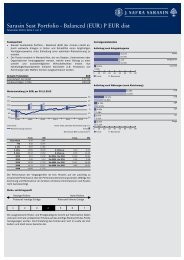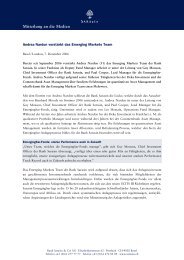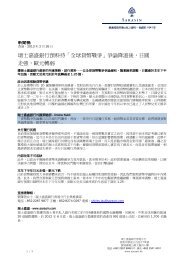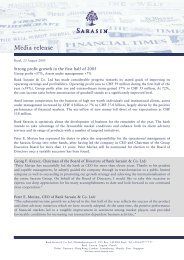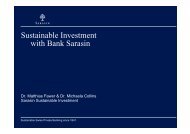Sustainability Report - Bank Sarasin-Alpen
Sustainability Report - Bank Sarasin-Alpen
Sustainability Report - Bank Sarasin-Alpen
You also want an ePaper? Increase the reach of your titles
YUMPU automatically turns print PDFs into web optimized ePapers that Google loves.
Solar Energy 2005<br />
production output, thin-film technologies (amorphous silicon, CdTe, CIS, etc.)<br />
were unable to keep pace with the market.<br />
Despite optimisation,<br />
significant cost savings only<br />
possible with new technologies<br />
We think the shortage of silicon will encourage the development of more efficient<br />
technologies. In crystalline silicon technology, the focus is on thinner wafers with<br />
bigger dimensions and improved efficiency. Most providers are not attempting to<br />
make any fundamental changes in the design and manufacture of cells, and<br />
have still managed to achieve significant progress so far with this strategy.<br />
Fig. 7: Market shares of different solar cell technologies<br />
100%<br />
Monocrystalline Polycrystalline Ribbon/Sheet a-Si CdTe CIS<br />
90%<br />
80%<br />
70%<br />
60%<br />
50%<br />
40%<br />
30%<br />
20%<br />
10%<br />
0%<br />
1999 2000 2001 2002 2003 2004<br />
Source: Photon, April 2005<br />
Technological innovation<br />
across a broad front<br />
The second strategy manufacturers pursue is to research innovative materials<br />
and technologies and try them out in pilot production. These initiatives entail a lot<br />
of research and considerable risks, but they also potentially offer big cost savings<br />
in the long run by substantially improving efficiency ratios. Innovations include,<br />
for example, ultra-thin crystalline cells, tandem and concentrator cells or<br />
organic solar cells.<br />
The major PV markets<br />
Installed PV<br />
capacity up 62%<br />
Germany takes over the<br />
lead from Japan<br />
Preliminary comment: In contrast to information provided previously about the<br />
quantities of solar cells produced, in what follows we are dealing with PV capacity<br />
actually installed in the form of PV systems. According to IEA-PVPS, globally<br />
installed PV capacity reached approximately 840 MW in 2004 (PVPS countries<br />
770 MW + non-PVPS countries 70 MW) while the market report published by<br />
Solarbuzz put the figure as high as 927 MW. This is equivalent to growth of 43%<br />
(or 62%) on last year.<br />
Last year Germany overtook Japan with growth of 137%, to achieve 363 MW of<br />
newly installed capacity. In Japan 272 MW were installed last year, an increase<br />
of 22% on 2003. These two countries now account for 68% of globally installed<br />
PV systems. In 2004 growth in the US came to 43%, to reach 90 MW newly installed<br />
capacity. The dominant nations in installing PV capacity are still Germany,<br />
Japan the US (in that order). Together they accounted for roughly 86% of<br />
the newly installed global capacity in 2004. These countries have dominated the<br />
industry for years, as reflected in the cumulative totals for installed capacity.<br />
Here Japan leads the way (1,132 MW), followed by Germany (794 MW), the US<br />
Dezember 2005 18


